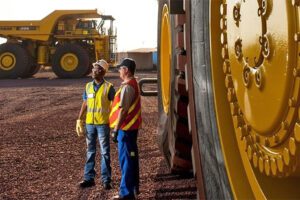[hr]With the exception of the few Australian states with a greater mining presence having their o wn specific mining work health and safety (WHS) Acts and Regulations, the mining industry is governed by the general state and territory WHS legislative framework along with the model mining WHS regulations, codes of practice and recognised Australian standards.[hr]
While a few differences remain between the different jurisdictions for the mining industry despite the attempted harmonisation of WHS laws in Australia, the duty to ensure the health and safety of workers and other persons at a mine remains the same, as do the consequences of noncompliance.
Employers have a duty to identify hazards and risks and introduce measures to ensure those hazards and risks are reduced ‘so far as reasonably practicable’. This high standard imposed on employers to ensure health and safety ‘so far as reasonably practicable’ and how employers determine what is ‘reasonably practicable’ to meet a health and safety duty in the mining industry is certainly a legislative minefield which requires specialised and careful consideration.
Unfortunately, employers cannot avoid all hazards and risks, incidents do happen and some are more serious than others. With overlapping obligations between the myriad of WHS acts and regulations, codes of practice, guidelines and Australian Standards, the burden of the duty to ensure the health and safety of workers and persons at a mine ‘so far as reasonably practicable’ can be overwhelming to mine operators, particularly when an incident does occur.
For example, if an incident occurs in Queensland on a petroleum lease with an overlapping mining lease near a Queensland motorway, the Petroleum and Gas (Production and Safety) Act 2004 (Qld), Coal Mining Safety and Health Act 1999 (Qld) or the Work Health and Safety Act 2011(Qld) and their respective regulations will need to be considered. This is not a simple task.
A proactive approach if or when an incident occurs is as important as ensuring health and safety, particularly in the mining industry.
INCIDENTS
Many employers have been fortunate and have not experienced any incidents at their workplace and erroneously believe that they ‘must be doing things right’ because there have not been any incidents at their workplace. Consequently, if an incident occurs, they are left scrambling for answers which could lead to fatal consequences.
Questions commonly raised by employers when an incident occurs are:
- What should I do?
- Have I done the wrong thing?
- Do I need to provide a statement to the investigator?
- Do I need to provide documents to the investigator?
- Should I call my insurer?
- What happens next?
- How much is this going to cost me?
The answers are not always clear. However, having a consistent approach to handling incidents detailed in an emergency response plan or strategy, if and when incidents do happen, will not only reduce delays when responding to incidents, it will also minimise the exposure to penalties for non-compliance.
EMERGENCY RESPONSE & CRITICAL INCIDENT PLAN
In the various WHS legislation, in addition to the general duty of care to ensure, so far as is reasonably practicable, that workers and other persons at a mine are not put at risk, it is a requirement for a mine operator to develop and implement a work health and safety management system (WHSMS) for the operation of the mine which should include, among other things, an emergency response plan.
For example, under the Coal Mining Safety and Health Regulation 2001 (Qld), a mine’s WHSMS must include provision for dealing with emergencies at the mine including but not limited to the following:
- identifying, by risk assessment, potential emergency situations;
- minimising risks associated with potential emergency situations;
- carrying out aided rescue and self-escape of persons from the mine in an emergency;
- carrying out emergency exercises, including testing the effectiveness of emergency management procedures and the readiness and fitness of equipment for use in an emergency; and
- auditing and reviewing the emergency exercises.
A critical incident management plan is also required to guide management personnel through the immediate steps once the emergency response is complete.
REPORTING INCIDENTS
The most important obligations and those steps which must be undertaken as a first response relate to the reporting of an incident and the preservation of the incident site. Many prosecutions as well as other actions taken have been in response to incidents.
It is a requirement under the WHS legislation that, as soon as practicable after becoming aware of a serious accident, high potential incident or a death at a mine, the Senior Site Executive (SSE) for the mine notifies an inspector and an industry safety and health representative about the accident, incident or death either orally or by written notice.
Failure to report a notifiable incident could attract significant penalties, including imprisonment. Under the mining WHS laws, deaths, serious injuries or illnesses, and high potential incidents are all notifiable incidents.
It is equally important to notify an insurer immediately of any incident whether serious or otherwise. Failing to notify an insurer within a certain timeframe may void indemnity.
INVESTIGATIONS
Following an incident, it is imperative that a thorough investigation is conducted, whether by an independent party or by the company.
When an investigation is being conducted, particularly when an inspector is conducting an investigation, it is important that speculation or theories of what occurred are not offered.
PROTECTION FROM SELF-INCRIMINATION
Under the various mining WHS laws, an inspector is able to compel an individual to answer questions unless an individual has a ‘reasonable excuse’ not to do so, except in high potential or serious injury incidents.
As most regulator investigations are regarding high potential or serious injury incidents, it is recommended that where persons are compelled to answer questions that each person claims protection against self-incrimination for the whole of the interview for all documents, information or answers provided.
However, the documents, information or answers given during compelled interviews may be used against other persons or a company.
LEGAL PROFESSIONAL PRIVILEGE
Involving a trusted and experienced WHS legal representative when, for example, preparing a WHSMS, conducting investigations, responding to incidents or when consulting with employees is also an important consideration.
Significantly, appointing an independent lawyer will mean that information (including photographs and reports) gathered for the dominant purpose of the provision of legal advice and/or for use in anticipated legal proceedings can be protected by legal professional privilege.
Above all, obtaining legal advice and considering your legal options at an early stage is paramount to protect the company, its officers and executives.
“Failure to report a notifiable incident could attract significant penalties, including imprisonment.”
PROFILE
MELISSA DEMARCO
 Melissa Demarco is a Senior Associate with CBP Lawyers in their Brisbane office. Melissa has extensive experience in advising large employers in highly unionised industries and has a record of delivering practical solutions in complex disputes. She has extensive experience advising employers on a variety of issues involving Work Health and Safety, discrimination and harassment, redundancy, performance management and workers’ compensation matters. In addition, she assists employers with issues arising from employment contracts, awards and industrial instruments and workplace policies.
Melissa Demarco is a Senior Associate with CBP Lawyers in their Brisbane office. Melissa has extensive experience in advising large employers in highly unionised industries and has a record of delivering practical solutions in complex disputes. She has extensive experience advising employers on a variety of issues involving Work Health and Safety, discrimination and harassment, redundancy, performance management and workers’ compensation matters. In addition, she assists employers with issues arising from employment contracts, awards and industrial instruments and workplace policies.
Melissa can be contacted on email: mmd@cbp.com.au














Add Comment